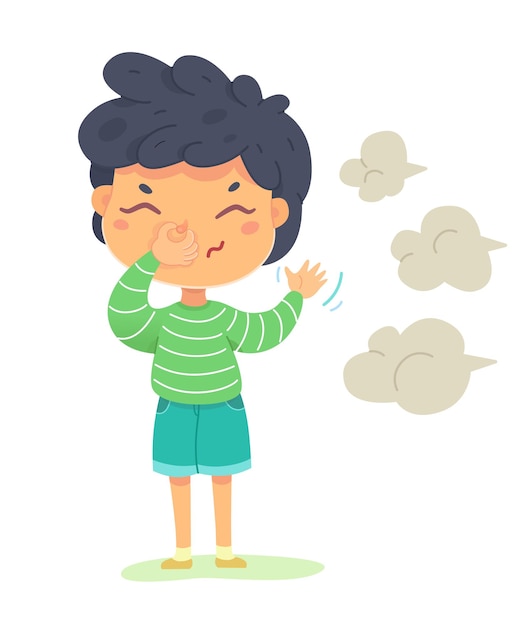
Bad breath, also called halitosis, often occurs in children due to poor dental hygiene or cavities. A little bad breath in the morning is normal and usually disappears after brushing teeth, eating, or drinking. However, persistent bad breath throughout the day is not normal and may require attention and treatment, especially if home care doesn’t help. It’s important not to ignore this issue, as it may indicate an underlying health concern.
Improving your child’s oral hygiene habits, such as brushing twice daily, flossing, and rinsing their mouth after meals, can often resolve the problem. However, if these steps don’t work, there could be a deeper issue causing the bad breath. Conditions like sinus infections, colds, allergies, respiratory infections, digestive problems, diabetes, liver or kidney disease, could be contributing factors.
Besides being unpleasant, bad breath can lead to emotional stress, anxiety, and social withdrawal for children. Here’s an overview of the common causes and treatments for bad breath in kids.
### Causes of Bad Breath in Children
1. **Poor Oral Hygiene**
The most common cause of bad breath in children is inadequate oral hygiene. When food particles remain in the mouth, they encourage bacterial growth, leading to bad odor. Food can get stuck between teeth, in gum pockets, or on the tongue. This can also lead to cavities and gum disease. It’s essential to establish a proper brushing and flossing routine and ensure parents supervise younger kids’ dental care.
2. **Foreign Objects**
Young children are naturally curious and may insert small objects like beads or toy parts into their nostrils. This can cause foul odors when these items become lodged and lead to bacterial growth. If this happens, consult a doctor immediately to have the object safely removed.
3. **Dry Mouth**
Active kids who don’t drink enough water may develop dry mouth, a condition where there isn’t enough saliva to cleanse the mouth of odor-causing bacteria. Dry mouth can also lead to other dental issues, such as cavities and tooth decay. Encourage your child to drink plenty of water to help maintain saliva production.
4. **Sinus Infections and Respiratory Issues**
Chronic sinus infections or colds can cause mucus buildup in the nasal passage and throat, providing bacteria a chance to thrive. This can result in persistent bad breath, unaffected by brushing or rinsing. If your child has symptoms like a sore throat, consult a doctor, as antibiotics may be needed to treat the infection.
5. **Gum Diseases**
Gum infections or cavities can emit a strong odor that brushing alone won’t resolve. If you suspect your child has gum disease or tooth decay, seek professional dental treatment as soon as possible.
6. **Infected Tonsils**
Inflamed tonsils with white spots can trap bacteria or food particles, emitting a foul smell. If your child’s tonsils appear red or swollen, visit a pediatrician for diagnosis and treatment, often involving antibiotics.
7. **Mouth Breathing**
Kids who breathe through their mouths, especially at night, can experience dry mouth, which reduces saliva and increases bacterial growth. Saliva is crucial for washing away odor-causing microorganisms, so this habit can make bad breath worse.
8. **Medications**
Long-term use of medications like antibiotics, antihistamines, and tranquilizers may decrease saliva production or alter the balance of bacteria in the mouth, exacerbating bad breath. Consult your doctor if you believe medication is a contributing factor.
9. **Tooth Decay or Periodontal Disease**
Decayed teeth provide an ideal environment for bacteria to thrive, making it difficult to clean. Restoring decayed teeth is the only way to fully resolve the odor in these cases. Similarly, untreated gum inflammation from plaque buildup can lead to bad breath. A dentist can address both issues effectively.
10. **Underlying Conditions**
Although rare in children, certain conditions like type 1 or type 2 diabetes, liver or kidney disease, stomach infections, or even respiratory illnesses such as asthma or enlarged adenoids can lead to bad breath. If symptoms persist, consult a healthcare provider for further investigations.
11. **Dietary Factors**
Foods like onions, garlic, and high-protein items like red meat or cheese can leave a strong odor. While these smells aren’t due to bacterial activity, they may linger until the body has processed these foods, excreting their byproducts through breath.
### Symptoms of Bad Breath in Children
– Persistent bad odor from the mouth.
– A sour or unpleasant taste that doesn’t go away.
– A white coating on the tongue.
– Dry mouth or difficulty producing saliva.
– Bleeding gums when flossing.
### Treatment and Prevention
To tackle bad breath, start with basic oral hygiene practices. Have your child brush their teeth twice daily using a dentist-recommended toothpaste, preferably one with antibacterial properties. Don’t forget flossing and tongue cleaning, as these help remove food particles and bacteria from areas brushing can’t reach. An antibacterial mouthwash can also help freshen breath.
Regular dental checkups are essential. Dentists can address issues like plaque buildup, cavities, and gum diseases, suggesting further treatments if necessary. For example, if your child has an inflamed tonsil causing odor, a pediatrician might prescribe antibiotics or other medications.
Bad breath caused by serious medical conditions, like liver or kidney disease, requires specialized treatment for the underlying problem. While these conditions are rare in children, they should not be overlooked if bad breath persists despite good oral care.
Encouraging your child to stay hydrated, limit strong-smelling foods, and adopt regular dental care habits can significantly reduce the chances of bad breath becoming a recurring issue. Early prevention lays the groundwork for a lifetime of healthy habits and confidence.